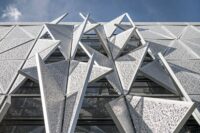- Home
- Articles
- Architectural Portfolio
- Architectral Presentation
- Inspirational Stories
- Architecture News
- Visualization
- BIM Industry
- Facade Design
- Parametric Design
- Career
- Landscape Architecture
- Construction
- Artificial Intelligence
- Sketching
- Design Softwares
- Diagrams
- Writing
- Architectural Tips
- Sustainability
- Courses
- Concept
- Technology
- History & Heritage
- Future of Architecture
- Guides & How-To
- Art & Culture
- Projects
- Interior Design
- Competitions
- Jobs
- Store
- Tools
- More
- Home
- Articles
- Architectural Portfolio
- Architectral Presentation
- Inspirational Stories
- Architecture News
- Visualization
- BIM Industry
- Facade Design
- Parametric Design
- Career
- Landscape Architecture
- Construction
- Artificial Intelligence
- Sketching
- Design Softwares
- Diagrams
- Writing
- Architectural Tips
- Sustainability
- Courses
- Concept
- Technology
- History & Heritage
- Future of Architecture
- Guides & How-To
- Art & Culture
- Projects
- Interior Design
- Competitions
- Jobs
- Store
- Tools
- More
Top AI Tools for Architecture Students in 2024: Elevate Your Design Skills

In the ever-evolving field of architecture, AI tools are revolutionizing how students approach design and planning. These cutting-edge technologies streamline workflows, enabling budding architects to create sophisticated 3D models and optimize building layouts with unprecedented efficiency. By integrating AI into their toolkit, students can focus more on creativity and innovation, rather than getting bogged down by technical constraints.
AI-driven platforms offer practical solutions for real-world challenges. For instance, they can analyze traffic patterns, air quality, and noise levels, providing invaluable data that impacts every design decision. This not only enhances the learning experience but also prepares students for the complexities of modern urban planning. As architecture students embrace these tools, they’re not just learning to design buildings—they’re shaping the sustainable cities of tomorrow.

Table of Contents
ToggleOverview of AI Tools in Architecture
Benefits for Students
AI tools revolutionize architectural education by simplifying complex tasks. These technologies enable students to develop 3D models quickly and accurately. For example, Autodesk Forma allows for the creation of 3D massing models with automatic data sets. This saves time and lets students focus on creativity. AI-driven platforms like Finch offer real-time techniques to optimize building designs, providing instant feedback to improve layouts.
Moreover, AI tools enhance decision-making by offering data-driven insights. Sidewalk Labs utilizes machine learning to analyze factors like traffic patterns and air quality, impacting every design choice. This not only helps in creating efficient plans but also fosters a deeper understanding of how various factors influence architectural projects.
Integrating AI into Architectural Education
Incorporating AI into the curriculum enriches the learning experience. Students gain hands-on experience with cutting-edge technology, aligning their education with industry standards. Practical tools like Autodesk Forma and Finch enable students to experiment with different design possibilities, ensuring compliance with regulatory standards and optimizing layouts efficiently.
Integrating sensors for data collection, as seen in platforms like Sidewalk Labs, gives students real-world exposure. They learn to evaluate environmental impacts and create sustainable urban designs. This prepares them for professional challenges, making their transition from academia to industry seamless.
By using AI tools, architectural students become proficient in emerging technologies, positioning themselves ahead in a competitive field. The enhanced learning experience not only boosts their skills but also equips them with practical knowledge to tackle the complexities of modern architecture.

Key AI Tools Categories for Architecture Students
Design and Conceptual Tools
Design and conceptual tools like Midjourney and Adobe Firefly give students the ability to visualize their ideas quickly. Midjourney generates photorealistic images from written prompts, aiding in illustrating complex designs. Adobe Firefly offers a versatile platform for creating images and text effects, which ignites creative thinking and helps in the early stages of architecture projects.
Schematic and Detailed Design Tools
Schematic and detailed design tools such as ArkDesign and Maket.ai streamline the process of creating optimized schematic designs. ArkDesign enables quick generation of detailed floor plans focusing on profitability and space utilization. Maket.ai’s advanced pattern recognition algorithms automate the generation of thousands of design options, allowing more time for creativity and detailed development.
Urban and Environmental Planning Tools
Urban and environmental planning tools like Sidewalk Labs offer data-driven insights for designing sustainable cities and neighborhoods. These tools provide practical advice on using technology for sustainability and collect data on traffic patterns, air quality, and noise levels. This information impacts every design choice, helping students make informed decisions about urban planning.
3D Modeling and Visualization Tools
3D modeling and visualization tools like Autodesk Forma and RoomGPT simplify the process of creating detailed massing models and realistic interior designs. Autodesk Forma allows for automatic data set integration, while RoomGPT caters to both nonprofessionals and experts in generating 3D living spaces. These tools enhance the visual representation of architectural ideas, making it easier to communicate and refine designs.

Impact of AI on Architectural Practices
Efficiency and Precision
AI tools significantly enhance efficiency and precision in architectural practices. Tools like Finch and Ark Design AI enable rapid optimization of building layouts. Finch, for example, uses graph technology to optimize building designs in real-time. It allows architects to reconfigure layouts instantly, ensuring compliance with regulatory standards using its built-in error prevention feature. Ark Design AI provides automated cost estimation and smart 3D rendering, producing optimized building designs that meet specific project requirements. These tools reduce manual errors and save valuable time by automating repetitive tasks, allowing architects to focus on creativity and innovation.
Sustainability and Innovation
AI in architecture fosters sustainability and innovation. Digital Blue Foam uses AI to streamline construction documentation with a focus on sustainable urban development. Its generative design capabilities, coupled with spatial analytics, ensure projects are not only innovative but also environmentally compliant. Sidewalk Labs leverages machine learning to generate multiple design possibilities quickly, incorporating data on traffic patterns, air quality, and noise levels to create more sustainable urban environments. This integration of AI in the design process leads to smarter, more efficient, and environmentally-conscious architectural solutions. By prioritizing sustainable designs, AI tools help architects meet growing environmental demands and encourage innovative solutions in their projects.
Future Trends in AI for Architecture
Emerging Technologies
Emerging technologies in AI provide powerful tools for architecture students. These innovations significantly impact the way we approach design and planning. Generative design algorithms, for example, allow the creation of multiple design options in minutes, considering factors such as space, light, and material usage. Autodesk Forma excels in this by using machine learning to optimize building layouts.
Smart data analytics also play a crucial role. Tools like Sidewalk Labs leverage data from sensors to inform urban design decisions. This includes data on traffic patterns, air quality, and noise levels, which helps create more livable and sustainable environments. Meanwhile, advancements in AI-driven 3D printing and construction robotics offer new ways to bring digital designs to life with greater precision and speed.
Predictions for Academic and Professional Use
AI’s role in architecture education is set to expand. We predict that AI tools will become integral in academic curricula, enabling students to learn industry-standard practices early on. Software like Finch offers real-time feedback on design iterations, allowing students to refine their techniques more efficiently.
In the professional realm, architects will increasingly rely on AI to streamline workflows. AI tools will facilitate everything from initial design concepts to final construction plans, thus reducing time and costs. Platforms like ARCHITEChTURES automate routine tasks, freeing up architects to focus on creative problem-solving and innovative design.
As AI continues to evolve, its integration will transform both education and professional practice. We anticipate that AI will not only enhance efficiency but also push the boundaries of what’s possible in architectural design. This convergence of technology and creativity represents the future of the architectural profession, shaped by data-driven insights and automated precision.

Conclusion
Incorporating AI tools into architectural education equips students with the skills to navigate an increasingly digital landscape. With software like Autodesk Forma and Finch, students can explore advanced 3D modeling, enabling them to create intricate designs efficiently. These platforms streamline complex processes, allowing budding architects to focus on creativity and innovation.
Platforms such as Sidewalk Labs offer valuable insights for urban planning by analyzing data to improve traffic management, energy efficiency, and housing affordability. This exposure to real-world applications enhances students’ understanding of sustainable design practices, making their proposals more relevant and impactful.
Emerging technologies like generative design algorithms facilitate rapid ideation by providing multiple design options in mere minutes. This accelerates the conceptual phase, allowing students to experiment with various layouts and structural elements without the constraints of manual drafting.
Smart data analytics tools help future architects incorporate sensor data into their projects, fostering intelligent and sustainable urban planning. By understanding and utilizing these advanced analytics, students can design buildings and spaces that respond dynamically to environmental conditions and human behavior, leading to more adaptable and resilient structures.
AI tools are revolutionizing architectural education by automating routine tasks and enhancing design precision. These tools help integrate AI seamlessly into academic curricula, providing students with a comprehensive understanding of both theoretical and practical aspects of modern architecture. As AI continues to evolve, its role in architectural education will undoubtedly expand, pushing future architects to new heights of innovation and efficiency.
- 2024 AI tools for architecture
- AI applications for architecture 2024
- AI architecture design software
- AI design software for architecture students
- AI design tools for architecture students
- AI for architecture design skills
- AI tools for student architects
- AI-powered design tools for architecture
- Artificial intelligence tools for architecture students
- Best AI tools for architecture students
- Elevate design skills with AI
- Top AI software for architecture design
Submit your architectural projects
Follow these steps for submission your project. Submission FormLatest Posts
Veo 3 for Architecture: Free Prompts & How to Master Visual Design Videos
Veo 3 introduces AI-powered video generation for architecture, allowing designers to present...
Midjourney Video Update: A New Era for AI Architecture & Landscape Design
Midjourney’s new video feature introduces AI-powered animation for architectural and landscape renders,...
Google Nano Banana and Architecture: What This New Image Generator Means for Designers
Nano Banana is a new benchmark for testing how well AI models...
The Ethics of AI in Architecture
Ethics of AI in architecture, clarified: bias audits, human-in-the-loop guardrails, IP and...












Leave a comment